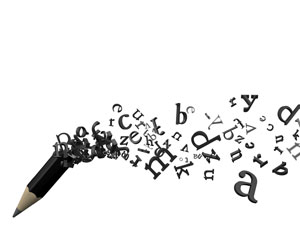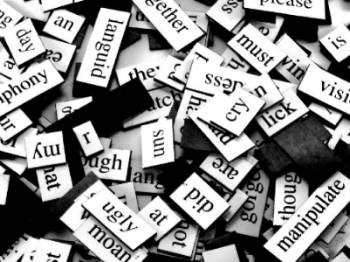- Las Positas College
- Reading & Writing Center
- Reading Poetry
Reading & Writing Center
Poems Made Easy …okay, easier!

Do your palms get sweaty and your stomach jumpy when you are assigned to read a poem for class? Do you dread looking at poetry because it’s so hard to figure out what the author is trying to say? You’re not alone!
You may have had well-meaning friends tell you to relax, that “poems mean whatever you think they mean. ” Unfortunately, it’s not QUITE that easy, but here are some ways to tackle a difficult poem and break it down so that you can get something out of it.
First of all, a poem contains many elements, and it can be read for other purposes than simply deciphering the meaning – just like we listen to music for many other reasons than dancing! If the poem’s meaning is confusing, first try to notice and appreciate these other elements:
Images
Poems, like dreams, rely on images to convey ideas: rather than telling us things, they sometimes just show us things.
For example, look at the following section of the poem "The Fish" by Elizabeth Bishop. The speaker is describing a fish that she caught.
He hung a grunting weight,
battered and venerable
and homely. Here and there
his brown skin hung in strips
like ancient wallpaper,
and its pattern of darker brown
was like wallpaper:
shapes like full-blown roses
stained and lost through age.
He was speckled with barnacles,
fine rosettes of lime,
and infested
with tiny white sea-lice,
and underneath two or three
rags of green weed hung down.
Reading this section of the poem, you might notice how the fish is described as as well as the feelings you get from these descriptions.
| Description | Feeling |
|---|---|
| His skin is brown and hangs in strips. | He's not very good looking! He looks like he's been through a lot. |
| She keeps saying he looks like wallpaper. | She once says "ancient wallpaper," so I think wallpaper is something you'd find in an old house. Old houses are ugly and run-down but also comforting and sweet. |
| He's got lots of stuff growing on him! He has barnacles, sea-lice, and seaweed. | This could indicated weakness, but he's described as strong in other parts of the poem. So I think it's not really bothering him that all this stuff is living on him. It's like he's so tough that he doesn't care. He's kind of like an old soldier with battle scars. |
Exploring images in this way helps give readers ideas about the meaning or effect of the poem. From examining the image above, we can tell that the fish has been through a lot and is very strong and tough. We can also see that there is a kind of beauty or honor in the fish's ugliness.
Your Turn
Now turn to a poem that you are reading for class or for fun. Read the poem out loud a few times, and underline the lines, phrases, or words that create a picture in your head. Ask yourself the following: What do I see when you read these words? What feeling do I get from the image? Jot some of these pictures and feelings down in the margins, connecting your notes to the words in the poem. You could also make a chart of images and feelings like the one above.
Sounds
If the poem’s meaning can be thought of as “the mind of the poem,” or the idea behind it, it’s still really made up of words, which themselves are made up of sounds. The sounds of the words could be thought of as “the body of the poem.” Of course, one of the first things you might notice is whether the poem rhymes or not. If it doesn’t rhyme, you may wonder what kinds of things are happening with the sounds of the words.
The following lines are the opening of the poem, "Daddy" by Sylvia Plath. This poem does have rhymes in it, as well as other interesting-sounding words.
You do not do, you do not do
Any more, black shoe
In which I have lived like a foot
For thirty years, poor and white,
Barely daring to breathe or Achoo.
Daddy, I have had to kill you.
You died before I had time--
Marble-heavy, a bag full of God,
Ghastly statue with one gray toe
Big as a Frisco seal
And a head in the freakish Atlantic
Where it pours bean green over blue
In the waters off beautiful Nauset.
I used to pray to recover you.
Ach, du.
Reading this poem aloud, you might notice that it has many noticeable sounds in it. How do these sounds affect you as a reader?
| Rhymes and Other Sounds | Effect |
|---|---|
| Almost all of the rhyming words end with the same sound, "oo." There are no other rhymes in this section. | This makes the poem sound very repetitive, like a child's nursery rhyme. |
| There's an internal rhyme (a rhyme within a line): "bean green." | This is a simple rhyme, with simple, short words--again, it sounds childlike. |
| The poem has a lot of short words with hard sounds like "black shoe" and "achoo." | This makes the poem sound angry. Maybe Plath is angry. |
Looking at these sounds and their effects, we might imagine that the poet is writing from the perspective of a child since the words are simple and sound like a nursery rhyme. We might also imagine that this child is angry at her father, since the poem is called "Daddy" and the sounds in it are very harsh and cold.
Your Turn
Now turn to the poem that you are analyzing. Make some notes about what you’re noticing
in the poem, sound-wise, and make some guesses about how the sounds might relate to
the overall subject or mood of the poem. You could write these in the margin of the
poem or make a chart like the one above. The following questions will guide you through
identifying sound in your poem in hopes to better understand it.
Identify sound patterns: Read the poem out loud again, paying attention to what the words sound like, not what
they mean. What do you notice about the poem’s sounds? Jot down any patterns you
notice.
Now, go ahead and identify whether or not the poem rhymes.
If it rhymes, try asking yourself the following questions:
hat kind of pattern is the author using? Are there places where the pattern is broken
or the author plays around with it? What effect does this have on you?
If it does not rhyme, try asking yourself the following qustions:
What kinds of things are happening with the sounds of the words? Are some lines more
fun to read, or smoother-sounding, than others? Are there any places where the author
might be using rough-sounding words on purpose? (For example, some words are softer
to say, like “lullaby,” and some are harder, like “backpack.”)
Structure
Poems look different on the page than prose – instead of paragraphs, poems are often divided into chunks called stanzas. In addition to stanzas, poems often end their lines differently than prose, which just runs to the margin of the page.
The following is an entire poem by Langston Hughes. While the poem is very short, it does have multiple stanzas and line breaks that contribute to its meaning.
A Dream Deferred
by Langston Hughes
What happens to a dream deferred?
Does it dry up
like a raisin in the sun?
Or fester like a sore--
And then run?
Does it stink like rotten meat?
Or crust and sugar over--
like a syrupy sweet?
Maybe it just sags
like a heavy load.
Or does it explode?
This poem has some very short stanzas along with one longer one. What effects does this structure have on the reader?
| Structural Feature | Effect |
|---|---|
| The first and last stanzas are only one line each. | This makes those sentences seem especially important. |
| The second stanza is the longest one. | It lists all the bad things that could happen to a "dream deferred." It lumps all these things together. |
| The third stanza only has two lines. | This separates "sagging" from all the other items in the list above. Maybe it stands out from the others in some way. |
| The lines seem to break between the bad thing that happens and the example, so a lot of the lines begin with "like." | This makes the elements in the poem seem parallel to each other. It gives a sense of repetition to the poem. |
Looking at this chart, we can see that the poem spends most of its space, its longest stanza, listing the many bad things that could happen to a dream deferred (meaning a dream that someone never gets to fulfill). However, the poem puts the most emphasis on the last two bad things, because they each have their own stanza. The dream might "sag like a heavy load"--this might mean become a heavy burden on the dreamer's soul. Or the dream might "explode"--this might mean turn into violent action, like committing a crime.
Your Turn
Turn to the poem that you are analyzing. As you use the following questions to help you break down the poem, write notes about
structure in the margin of the poem or make a chart like the one above.
Look at how the stanzas and lines are divided. Do the stanzas divide in any unusual places? How about the lines? What effect do
these divisions have?
Let's take a deeper look into the stanza arrangment. Read the poem again, paying particular attention to the way the stanzas are organized. Why do you think the author divided the stanzas this way? Is each stanza somehow
distinct from the others, in terms of topic or mood?
Finally
After examining your poem from these different angles the best you can and writing down whatever you’ve noticed, you can go back and ask again: does all this information help me understand more about what the poem means?
Even if the answer is no, or "I’m not sure," your notes have given you a little bit of progress towards connecting with the poem – and a few observations to contribute to class discussion! Happy reading!

This page was created by Toby Bielawski and Karin Spirn.

